
Welcome to Michigan Lakes!
We are all about Michigan lakes. Life on, in and near Michigan's lakefront brings a richness that rewards for a lifetime. Have a story or comments on your experience? You can be one of the first to share it with the world on our Michigan lake directory.
Lake Blog
2009 Michigan Antique Markets
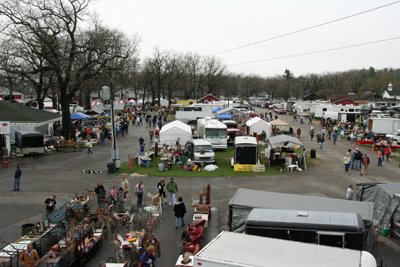 There are many signs of spring, warmer weather, the birds singing, flowers blooming and garage sale signs posted on every corner.
There are many signs of spring, warmer weather, the birds singing, flowers blooming and garage sale signs posted on every corner.
You also know it is spring because many outdoor flea markets and antique shows are taking place. These shows provide a great opportunity to discover something you were not looking for. Something you just can’t live without. Something to good to pass up. Something that brings a smile to your face every time you look at it.
Even if you go to a market and don’t buy anything, it never is a waste of time. There are always interesting things to see and interesting people to watch. Stop and take time to talk to the vendors. Ask some questions. They are a wealth of knowledge and you may leave with a new appreciation for something you never really thought about before. And, of course, it is always good to walk around and breath in the fresh air. Although, the air may be filled with the tantalizing aromas of elephant ears and popcorn!
Here is a list of some of the shows brought to my attention. If you know of others, please fill me in on the details. Help the Michigan economy and buy something.
May 9-10 Utica Antiques Market at Shelbyville, Macomb County
May 10, Centreville Antique Market, St Joseph Fairgrounds
May 16-17 Ann Arbor Antiques Market Washtenaw Council Farm Grounds
May 24 Allegan Antique Show Allegan County Fairgrounds
May 30-31 Michigan Antique and Collectable Festival at Midland County Fair Grounds
June 12 East Grand Rapids Antique Show, East Grand Rapids High School
June 13, Centreville Antique Market, St Joseph Fairgrounds
June 20-21 Ann Arbor Antiques Market Washtenaw Council Farm Grounds
June 28 Allegan Antique Show Allegan County Fairgrounds
July 11-12 Utica Antiques Market at Shelbyville, Macomb County
July 12, Centreville Antique Market, St Joseph Fairgrounds
July 18-19 Ann Arbor Antiques Market Washtenaw Council Farm Grounds
July 25-26 Michigan Antique and Collectable Festival at Midland County Fair Grounds
July 26 Allegan Antique Show Allegan County Fairgrounds
August 9, Centreville Antique Market, St Joseph Fairgrounds
August 14-16 Yard Sale Trail 200 Miles of Yard Sales, Antique Shops Along Lake Huron
August 15-16 Ann Arbor Antiques Market Washtenaw Council Farm Grounds
August 30 Allegan Antique Show Allegan County Fairgrounds
September 12-13 Utica Antiques Market at Shelbyville, Macomb County
September 13 Centreville Antique Market, St Joseph Fairgrounds
September 19-20 Ann Arbor Antiques Market Washtenaw Council Farm Grounds
September 26-27 Michigan Antique and Collectable Festival at Midland County Fair Grounds
September 27 Allegan Antique Show Allegan County Fairgrounds
October 17-18 Ann Arbor Antiques Market Washtenaw Council Farm Grounds
October 30-Nov 1 Southfield Pavilion Antiques Exposition, Southfield
Arcadia Lake
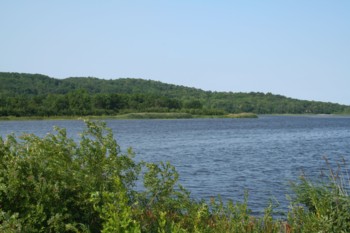 In the northwestern corner of Manistee County lies this often overlooked Michigan lake, Arcadia Lake located on the edge of Arcadia. Arcadia lies on the Lake Michigan shoreline and is home to several well known West Michigan destinations. The Arcadia Bluffs Golf Club is just south of town with 245 acres of lakefront on Lake Arcadia and 3,100 feet of waterfront on Lake Michigan.
In the northwestern corner of Manistee County lies this often overlooked Michigan lake, Arcadia Lake located on the edge of Arcadia. Arcadia lies on the Lake Michigan shoreline and is home to several well known West Michigan destinations. The Arcadia Bluffs Golf Club is just south of town with 245 acres of lakefront on Lake Arcadia and 3,100 feet of waterfront on Lake Michigan.
Arcadia is also home to the Camp Arcadia, a summer family camp on Lake Michigan operated by the Lutherans. Each year, thousands of guests come to enjoy the water, sun and the quiet of the camp.
Arcadia, like many other West Michigan resort communities, dramatically increases in population during the summer season. Those who live in the area love their scenenic surroundings.
Arcadia Lake, on the southern edge of the community, adds to the overall beauty of the area. On the east side of M22, nature lovers will appreciate the 170 acres of wetlands and the many species of wildlife that call the wetlands home.
Although being separated from Lake Michigan by the dunes, the lake is connected to Lake Michigan by a channel. There is a public access to the lake at the end of Pine Street featuring a hard surface boat launch with a fishing pier. No swimming is allowed at that location, but it is still a great spot to enjoy the water and catch a few fish.
Grand Mere State Park
Michigan is home to a number of wonderful state parks. Grand Mere State park is on of those parks. Located in Berrien Township in South Western Michigan near the Indiana border, this park boasts 985 acres of land and one mile of Lake Michigan waterfront. Natural sand dunes, deep blowouts and unforgettable Lake Michigan views make Grand Mere a park that stands out from the rest.
The park is known for its natural, untouched beauty. Three little known Michigan lakes are found here: North Lake, Middle Lake and South Lake. These three lakes are not your all sports lakes, they are shallow lakes more suitable for wildlife and duck blinds.
Rather than describe what you will find on the nature trails trough the park, we are including information found in the” handout available at the park.
Grand Mere State Park
Self Guided Nature Trail
1. The Great Sauk Trail: One of the principle Native American Migration Routes in Michigan passed close to the Grand Mere area. During the 1600’s and 1700”s several different tribes traveled through the area to each the St. Joe River. These tribes would camp along the shores of the inland lakes where they could fish as well as hunt beaver, muskrat, waterfowl, frogs and turtles before moving on.
2. Musclewood: (Carpinus caroliniana, bluebeech, hornbeam)Thrives in moist rich soils mainly along lakes and streams in the understory of hardwood forest. It is readily identified by it’s muscle-like ridges of the trunk. It’s other name, Hornbeam, is from the words “horn” (for toughness) and “beam” (for tree) referring to it’s very tough and hard wood.
3. South Lake: When the glaciers retreated, they left an area know as the Great Lakes Basin. In addition to the five largest freshwater lakes in the world, many smaller freshwater lakes are found across the terrain of Michigan. Here is South Lake, sister to North Lake. Two lakes, south of this lake, have since filled in are now wooded swamps, and remnants bogs. The waters from this inland lake system drain into Lake Michigan from an outlet off North Lake.
4. Tree cavities: Whether found near the ground or high up, tree cavities are beneficial nesting boles for many woodland creatures. Opossum, squirrel, fox, raccoon, bats and wood ducks are just a few of the animals that use tree cavities to raise young or seek safety. Cavities are formed when tree limbs and knots decay and fall off, exposing the sapwood and heartwood.
5. White Oak: (Quercus alba)* The classic White Oak of Eastern U.S. is found growing in moist well-drained uplands and lowlands. It is slow-growing, long-lived (500-600 years) and differs from it’s cousin in the Red Oak by having round-lobed leaves instead of bristle-tipped lobes of the red oak. It’s acorns mature in one season and are an important food crop for squirrel and deer. It’s also called “Stave Oak” because it’s wood, when cut into narrow strips (staves), is an outstanding material for making light barrels for whiskey.
6. Ferns: In place of flowers, fruit and seeds that enable most plants to propagate themselves, ferns have spores. Spores are a single-celled reproductive organ. They are dust-like and are hidden on the underside of the frond and upon maturity, burst, and scatter where they germinate. Ferns are characterized by compound leaves (frond) with divided leaflets. The four most common ferns found here are bracken, royal, sensitive and cinnamon.Red Oak: (Quercus rubra)* The red oak, whose leaf lobes are bristle-tipped, produces acorns that mature the second year. Read oak demands more moisture than white oaks, but they also tolerate colder climates. In the northern Lower and Upper peninsulas, red oak can be found on sandy, well-drained soils with white and red pines. It is an important lumber tree, it’s wood being used in flooring, furniture, fence posts, railroad ties and pilings. It is a rapid grower and is an important landscaping tree for parks and lawns.
8. Tipovers: In bottom land wood communities where the water table is close to the surface, the root complex of trees have a tendency to spread out laterally rather than grow downward. As the trees mature, much of their mass is above ground and they literally become top heavy without a deep root system to stabilize them. Periodically during strong storms with high winds, a tree will blow over, pulling it’s root system out of the ground. Occasionally, enough roots remain in the ground to keep the tree alive and it continues to grow literally laying down on the job. Otherwise, it will probably decay and provide food and shelter for forestland creatures.
9. Witch-Hazel: (hammamells virginiana) The interesting note on this tree is the time of flowering. Flowers appear in October and November and continue well after leaf fall. The tree is shade-tolerant, slow growing and short-lived. The forked twigs were used by water diviners or “well witchers” to seek water. Witch-Hazel astringent is obtained from the leaves, twigs and bark and used in lotions and medicinal extracts.
10. Sassafras: (Sassafras albidum) Favors well-drained soil and ample sunlight. It is easily identified by three distinct shapes of leaves on the same tree; unlobed, 2-lobed “mitten” and 3-lobed (rarely 5-lobed). Oil of sassafras is distilled from the bark of the roots. It is used to flavor medicines, candy, tobacco and soap. Sassafras tea, made from the rood bark (which has a distinct root beer odor) was used as a spring tonic to “thin the blood”.
*Oak Trees: Oaks are divided into two groups, white and read oaks, each group is comprised of many species. There are more than 400 oak species in the world. The white oak group is characterized by leaves with rounded lobes and acorns tat mature in their first year. The red oak group has leaves with bristle-tipped lobes and acorns that mature in their second year.
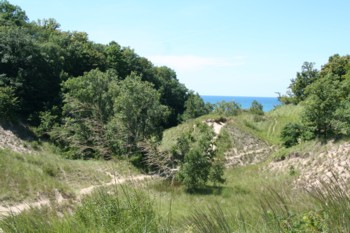
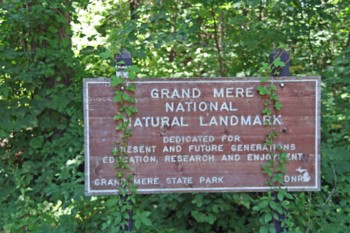
The Best Things in Life are Free
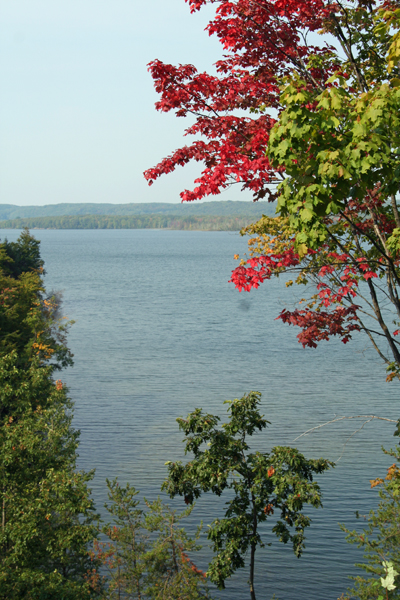
They say that the best things in life are free. Sometimes I think the best views in life are free.
Case in point, just a few miles south of Mesick on the east side of M37 is one of these best views.
The Michigan Department of Transportation (MDOT) offers a roadside park on the Hodenpyl Pond.
- pond is formed on backwaters of the Manistee River behind the Hodenpyl dam.
For your exercise, try the recently constructed stairs to the waterfront.
Weidman Michigan
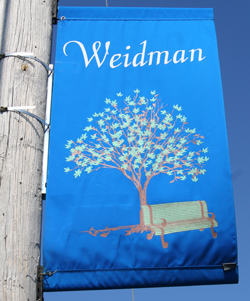 Weidman is a small, sleepy community in central Michigan’s Isabella County, just fifteen miles northwest of Mt. Pleasant. Weidman is located south of the Isabella Indian Reservation and north of Lake Isabella.
Weidman is a small, sleepy community in central Michigan’s Isabella County, just fifteen miles northwest of Mt. Pleasant. Weidman is located south of the Isabella Indian Reservation and north of Lake Isabella.
The Lake of the Hills is the centerpiece for Weidman. The lake is the backwaters of a dam in the Coldwater River. On any given summer day you can find someone boating, fishing or skiing.
Although the population is less than 1000 people, a visit to Weidman will show this to be a thriving community with a grocery store, bank and several churches. With it’s small town friendliness and easy parking, it is the perfect place to pick up some supplies for a weekend at the lake.
And, while traveling through Weidman, you may want to stop for a game of golf at one of the nearby golf courses. We recommend the Pines Championship Golf Course.
Because this community is in an area of small Michigan towns located on or near Michigan’s rivers or lakes, many people decide they can not leave and choose to retire here.
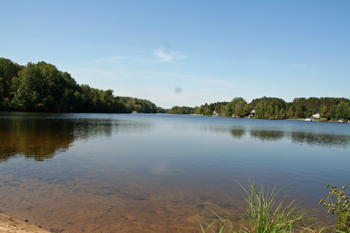
Professional Lake Management
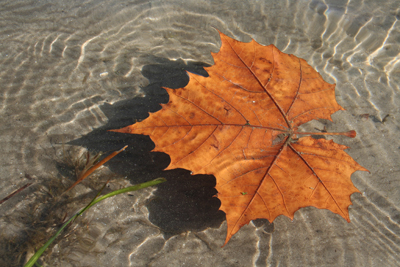 Over the years, I have noticed the trucks of Professional Lake Management pulling a trailer with an airboat down the road. I have thought many times that would be the ideal job! Can you imagine having a job where you can spend time on one of Michigan’s lakes in the morning, another in the afternoon?
Over the years, I have noticed the trucks of Professional Lake Management pulling a trailer with an airboat down the road. I have thought many times that would be the ideal job! Can you imagine having a job where you can spend time on one of Michigan’s lakes in the morning, another in the afternoon?
It has been rightly said, “Things always look greener on the other side of the fence.”
Recently I paid a visit to the office of Professional Lake Management and met Jason Broekstra, Vice President of Michigan operations. His experience with over 14 years in Aquatic Plant Management, coupled with a Bachelor of Science degree in Biology from Grand Valley State University, makes him the man with the answers.
The management of PLM operates with a simple and very clear plan; assessment, prescription, and implementation. I like to think of them as doctors to the lakes in Michigan.
Under their care are many of Michigan’s jewels, our beautiful Michigan lakes. During the summer months more than twenty crews are on the road taking water samples, performing vegetation surveys and treating the water.
 Many times potential clients call when they suspect something may be wrong with the water in the lake. The fish are not biting, the waters are murky and discolored, or there is a layer of algae on the surface of the water are some of the things they report. Algae can be a sign of poor water quality, indicating that a lake that can be out of balance. That is where the diagnosis starts.
Many times potential clients call when they suspect something may be wrong with the water in the lake. The fish are not biting, the waters are murky and discolored, or there is a layer of algae on the surface of the water are some of the things they report. Algae can be a sign of poor water quality, indicating that a lake that can be out of balance. That is where the diagnosis starts.
Our desire may be for a nice sandy beach with clear water and not a plant in sight, but that may not be the best for the health of the lake. Dr. Jason informed me that the aquatic water plants are very important to the ecosystem of the lake. At least that is the native vegetation, the exotic plants are the one ones that cause the problems. I learned that exotic plants are the plants that are not native to the area.
The native plants oxygenate the water. They provide habitat for the fish and stabilize the sediments (water clarity). Common exotic plants that have found their way into some of Michigan’s lakes are Eurasian Watermiloil and Curly Leaf Pondweed. PLM’s goal is to protect our Michigan lakes against these and other predatory species.
One method of control is by applying aquatic herbicide to treat the water. Your first thought is probably the same as mine, “What are the chemicals they are putting in the water I fish and swim in?” After all, we all have seen the yellow warning signs that they post after treatment. Jason assured me that all aquatic herbicides are closely regulated by the State of Michigan and must be approved by the state. Anyone applying herbicides must be certified in this area. Notices of herbicide application are a state requirement and must be placed on every lakefront property within 100 feet of the treatment area.
- recently explained in one of the company newsletters “Aquatic herbicides are designed to impact or disrupt biological processes specific to plants only. Plants have very different enzymes, physiological processes, growth, and metabolism than humans. Often, herbicides are designed to disrupt one specific plant process or enzyme which can cause the plant to shut down. Since humans and animals lack these biological processes and enzymes, herbicides do not have the same impact on us.”
Lake harvesting is also common in Michigan. The harvester is a floating machine that removes all weeds and algae by skimming it up. They can work in waters only two feet deep and can harvest up to four feet below the surface of the water. Harvesting works best for the control of native plants. Every lake is different, no two are the same, and that means their management will be different.
Lakes are catch basins for all sorts of things. They catch everything, including sediments from soil erosion, chemicals, fertilizers and leaky septic systems. There is much to be said for the preventive measures one can take to prevent unnecessary runoff to preserve the quality and life of the lake. That will be the subject of a future post.
Michigan Wetlands
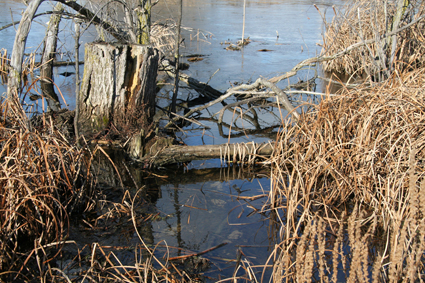 Wetlands are a very complex subject in Michigan. I will attempt a brief description, only to add to it later. They are often misunderstood, underappreciated and sometimes overlooked. They are enjoyed by many hikers, sportsmen and hunters.
Wetlands are a very complex subject in Michigan. I will attempt a brief description, only to add to it later. They are often misunderstood, underappreciated and sometimes overlooked. They are enjoyed by many hikers, sportsmen and hunters.
Wetlands are often described as a bog, a swamp or marsh. It is land where the soil is saturated with moisture. They are complex natural systems, and like Michigan’s lakes, no two are alike. They provide ecological balance and functions.
Wetlands are generally found in flat areas of vegetation as a depression on the landscape. Or, they are commonly found between the water and dry ground along a stream, river or lake.
Wetlands act much like a sponge during times of storms, snowmelt and high water levels. The wetlands can “absorb” much water thus preventing flooding. During times of low water levels, the waters are slowly released back into the lakes, rivers and streams. One estimate states one acre of wetlands can hold some 350,000 gallons of water if flooded one foot.
Wetlands are home to much wildlife and serve as stops for migrating birds. Many of our endangered species makes their home in wetland areas and a wide variety of plant life is found here.
Wetlands act as a filter for the waters of our lakes, streams and rivers. Wetlands remove the phosphates that can find their way into the ecosystem by way of runoff from lawns, farms, industrial plants and sewage. This removal greatly reduces the aquatic weeds and algae, which steal the oxygen that plants and animals need to survive. These weeds also steal vital nutrients such as nitrogen and phosphorus.
Over the years it is estimated we have lost one half of all wetlands in this country. Wetlands, or portions of them, have been filled in to build roads or railroads. They were drained for creation of farmland. And yes, they were filled in along many of Michigan’s lakes and rivers to become home sites.
A permit from the DEQ is required to deposit fill or permit the placing of any fill material in the wetland area. A permit is also required to dredge, or remove any soil or minerals from the wetland area or to drain surface water from wetland area. When constructing or developing any area within the wetland area, you would be required to obtain a permit before any work could begin.
If in doubt, ask!
One Morning
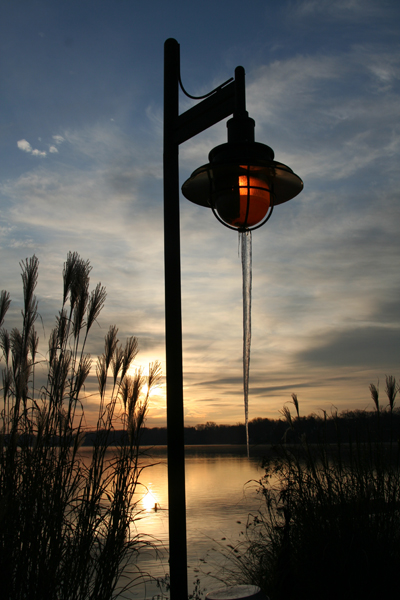 As I was about to head out one cold morning last week, I noticed the colors in the sky were beginning to look particularly interesting. So, of course, I grabbed the camera.
As I was about to head out one cold morning last week, I noticed the colors in the sky were beginning to look particularly interesting. So, of course, I grabbed the camera.
I was approaching a nearby lake when the sun began to rise, so I stopped at the lake to see if I could capture the sunrise.
While shooting the sunrise, I noticed this malfunctioning streetlight, glowing an amber color, reflecting the colors of the rising sun. A large icicle had formed on this streetlight, and to me, this picture captures the silent coldness I experienced that early morning on the lake.
I am not sure why there was an icicle on this particular light post, there were no icicles on the other lights. For that matter, this was the only icicle I saw that day. But, it was beautiful and a great way to start my day.
If you keep your eyes open and are always on the lookout for the unexpected, there will always be something new to experience on a Michigan lake!
Michigan lakes
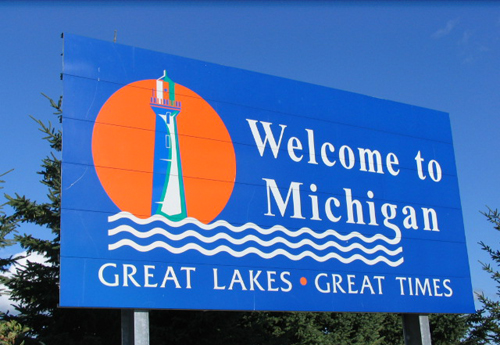 Michigan lakes make Michigan a haven for water lovers everywhere. With a reported 11,037 inland Michigan lakes and no two of them alike, Michigan is unique among states.
Michigan lakes make Michigan a haven for water lovers everywhere. With a reported 11,037 inland Michigan lakes and no two of them alike, Michigan is unique among states.
Michigan lakes include some of the largest bodies of fresh water in the world. Four of the five Great Lakes touch Michigan’s shores, giving it the nickname of “The Great Lake State”. Lake Michigan, Lake Superior, Lake Huron and Lake Erie provide many miles of beautiful beaches within driving distance from anywhere in the state. Michigan has the largest freshwater shoreline in the world. Only Lake Ontario only does not border the state of Michigan.
Michigan lakes provide year round activity for Michigan residents and residents of nearby states. The lakes come in more than the three sizes of: Small, Medium and Large. Some of the larger Michigan lakes that make Michigan unique are, Houghton Lake (20,044 acres), Torch Lake (18,770 acres), Mullett Lake (17,360 acres), Lake Charlevoix (17,260 acres), Burt Lake (17,120 acres), Black Lake (10,130 acres), Crystal Lake (9,711 acres), Higgins Lake (9,600 acres), Hubbard Lake (8,850 acres), Elk Lake (7,730 acres),Glen Lake (6,285 acres), Grand Lake (5,660 acres) Long Lake (5,600 acres), Lake Leelanau (5,370 acres), Wallon Lake (4,320 acres), Lake Mitchell (2,580 acres) and many other large lakes located in northern Michigan.
There are also many midsized Michigan lakes. Lakes like Chippewa Lake , Martiny Lakes, Randall Lake, Lake Macatawa, Douglas Lake, and the hundreds of other lakes that over five hundred acres in size make wonderful memories for many families for years to come.
Michigan has many other lakes, some named, some unnamed, each with it’s own unique beauty and character. Some are known for fishing, some for all sports activities, some are just waiting to be explored, discovered and enjoyed.
When it comes to Michigan lakes, the proof is in the numbers. Michigan is ranked third for the number of registered recreational boats in the county, behind only Florida and California. With 3,288 miles of lakeshore, Michigan has the second largest shoreline of any state, second only to Alaska. A person is never more than 6 miles from a natural water source in the state, or never further than 87 miles front the Great Lakes coastline. Michigan has some 150 lighthouse, more than any other state.
With all the negative talk out there about Michigan, the economic pressures that the state faces and the challenges that lie before us, it is time for all of us to concentrate on all the assets that Michigan has that no other state in the country can begin to match.
Road Ends
 You may have seen signs similar to this one that reads, “Road Ends”. Over the years, as many Michigan lakes were developed and platted, roads were planned. Some were built, many remained unbuilt. A number of plats included roads that ended at the water’s edge. Many of these roads are rights of ways, or easements, can vary in width from sixty six feet down to as narrow as five feet wide.
You may have seen signs similar to this one that reads, “Road Ends”. Over the years, as many Michigan lakes were developed and platted, roads were planned. Some were built, many remained unbuilt. A number of plats included roads that ended at the water’s edge. Many of these roads are rights of ways, or easements, can vary in width from sixty six feet down to as narrow as five feet wide.
In these cases, many questions arise. Who has the what rights to use that water frontage and what can they do there? Can a boat be launched there? If so, who has the rights to launch a boat? Can a dock be placed there? If so, who has the rights to do so? Can a boat be moored there and for how long? Overnight? What about a boat lift?
Questions arise regarding the use inside the right of way or easement. Can one use the area for a family picnic, sunbathing, swimming, fishing or parking of vehicles or trailers?
Now years later, that intent is somewhat vague. Many plats were marked simply “For Public Use” without any description of what was acceptable and what was not. Through many court cases, the answers seem to lie in the intent of the original developers (dedicators of the easement or right of way).
Rather than try to boil it down to this short post, check out a very informative document on line that is well worth the read. It covers the issue from several perspectives.
Generally speaking, if you have legal way to get to the water (via a road end), you have the legal right to use the water. It would be considered for access of in and out use only, not as a site for the family reunion.
There are many ways to enjoy the Michigan Lakes.
Interlochen State Park
Interlochen State Park is situated between two well-known Michigan fishing and swimming lakes. The Odawa tribe originally named the lakes Wahbekaness and Wahbekanetta. Today they are known as Duck Lake, a Michigan lake of 1930 acres with reported depths of up to 98 feet, and Green Lake, a lake of 2000 acres with reported depths of up to 98 feet.
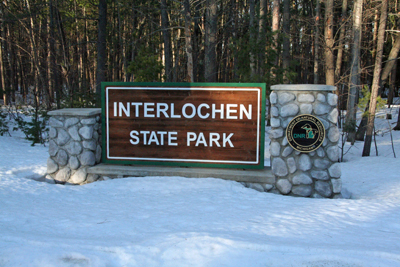 Both lakes reportedly contain Bluegill, Brown Trout, Lake Trout, Largemouth Bass, Northern Pike, Pumpkinseed, Rock Bass, Small Mouth Bass, Splake and Yellow Perch. Parks that have frontage on more than body of water offer twice the amount opportunity for enjoyment. If fish are not biting in one lake, you can move to the next!
Both lakes reportedly contain Bluegill, Brown Trout, Lake Trout, Largemouth Bass, Northern Pike, Pumpkinseed, Rock Bass, Small Mouth Bass, Splake and Yellow Perch. Parks that have frontage on more than body of water offer twice the amount opportunity for enjoyment. If fish are not biting in one lake, you can move to the next!
Interlochen State Park, or Pine Park as it was originally named, became Michigan’s first state park by the Michigan Legislature in 1917. The park was purchased for $300.00 an acre, which came to $60,000 for this 200 acre parcel of rolling wooded land. The intent of this purchase was to preserve the virgin pine stand for the future people of Michigan to enjoy.
Interlochen State park offers 490 campsites, updated restrooms, trails and a camp store. If you can’t find what you need, supplies can be found just down the road in the village of Interlochen. Adjacent to the park, you will enjoy the Interlochen Center for the Arts with it’s world renowned summer camp. This camp is known as a summer camp for the arts offering many summertime events.
More Articles...
- Michigan State parks
- Summer Nook
- Bridge Over the Grand River
- I am waiting for you
- Michigan City
- No Name lake
- Is it a lake?
- Cartier Mansion
- Pictures or Photographs?
- The Badger
- The Car Ferries
- Happy Fourth of July
- Ada Covered Bridge
- Thornapple River
- Michigan Pumpkins
- Lowell Showboat
- Cannonsburg Michigan Information
- Pickerel Lake and Memories
- Big Crooked Lake
- A Good Shot!
- Indian Joe
- To Seed or not to Seed

